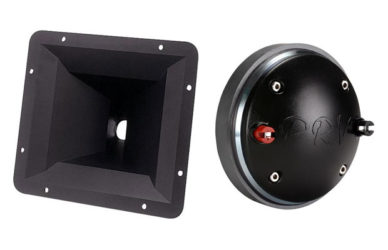| Here is another horn that looks good with 8″~12″ woofers. The Pyle PH810 measures approximately 10″ W x 8″ H and has a coverage of 90° H x 40° V. Cut-off frequency is stipulated at 1kHz. It fits 1″ throat compression drivers with standard 1-3/8″ -18 screw threads. Made of ABS resin. | |
| Finding the right compression driver
Fig 1 shows five compression drivers with the PH810. All measurements are RAW, ie without crossover and EQ. Plots are displaced for easy comparison. Blue trace = Dayton D250P |
 (Fig 1) No Smoothing, Mic at 1 meter tweeter axis, 5 msec gating |
| PRV D280Ti with Pyle PH810
From Fig 1, it seems that all the drivers can be used. I decided on the PRV D280Ti because it has the least peaks and valleys. My approach is always to avoid using EQ if possible. The Black trace is Fig 2 is the RAW response. The Red trace is RAW but with the CDEQ on my electronic crossover activated. The Blue trace is at 2kHz with CDEQ. Apart from a 2.5dB dip at 3.5kHz and 9kHz, the response is pretty flat up to 15kHz. |
 (Fig 2) Pyle PH810 with PRV D280Ti |
| Incorrect Summing
Fig 3 is with the D280Ti/PH810 crossed to a Dayton RS180S woofer. Electronic crossover was set at 2kHz (24dB/oct) with CDEQ on. The Red trace is the summed response. Due to the large acoustic centers offset, a notch was observed at 2kHz. |
 (Fig 3) |
| PRV D280Ti Phase Inverted
Fig 4 is with the compression driver, D280TI, rewired for Inverted Phase. Now, the notch shifted to the left. |
 (Fig 4) |
| Delay added to RS180S with PRV D280Ti Phase Inverted
Fig 5 is with delay added to the RS180S. The delay time is adjusted until a deep notch appears. This will be exactly at the acoustic crossover point (1.8kHz). |
 (Fig 5) |
| Proper Summing through Time Alignment
Fig 6 shows the correct summing when the D280Ti is re-wired back to normal phase.
|
 (Fig 6) |
